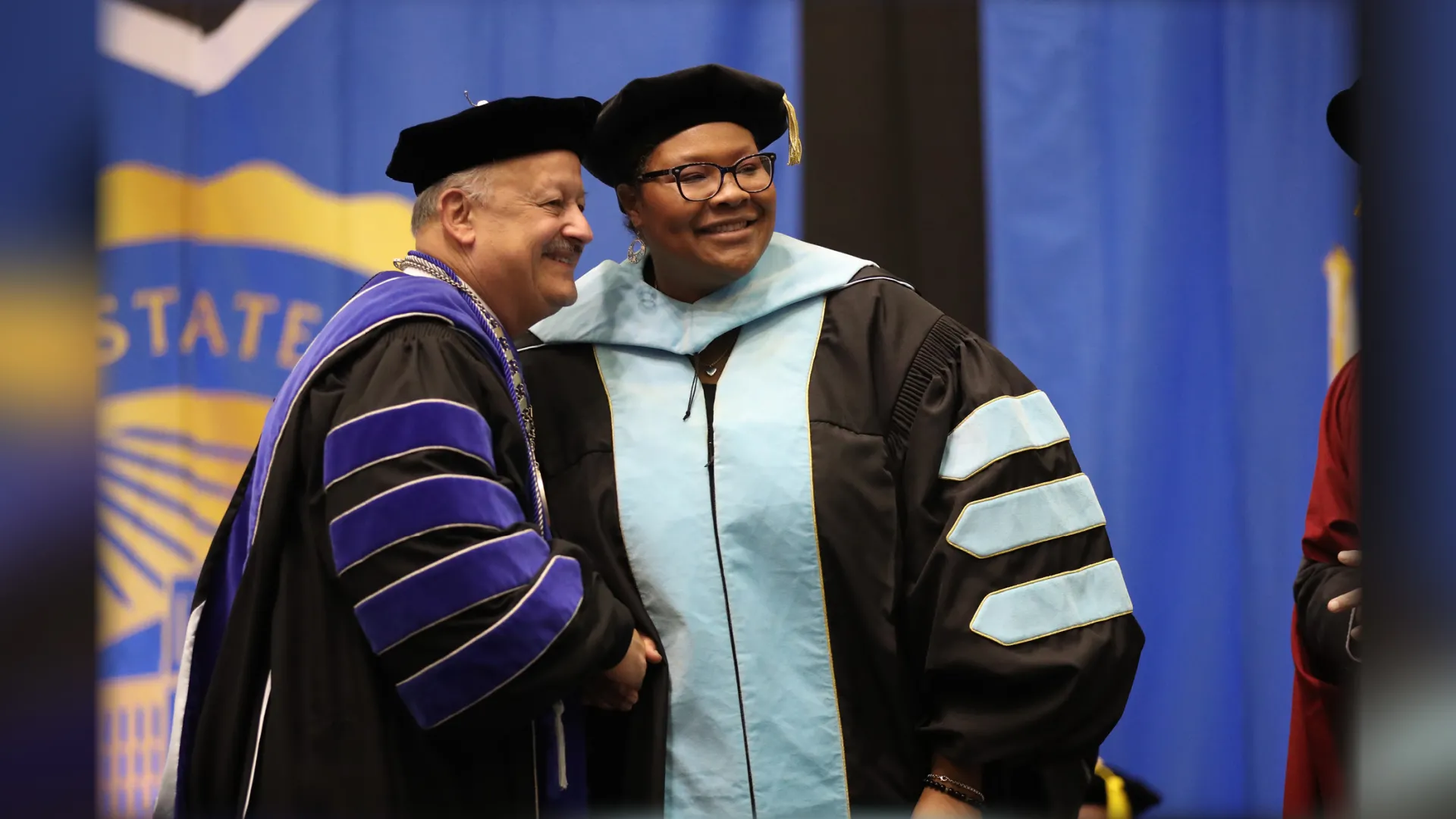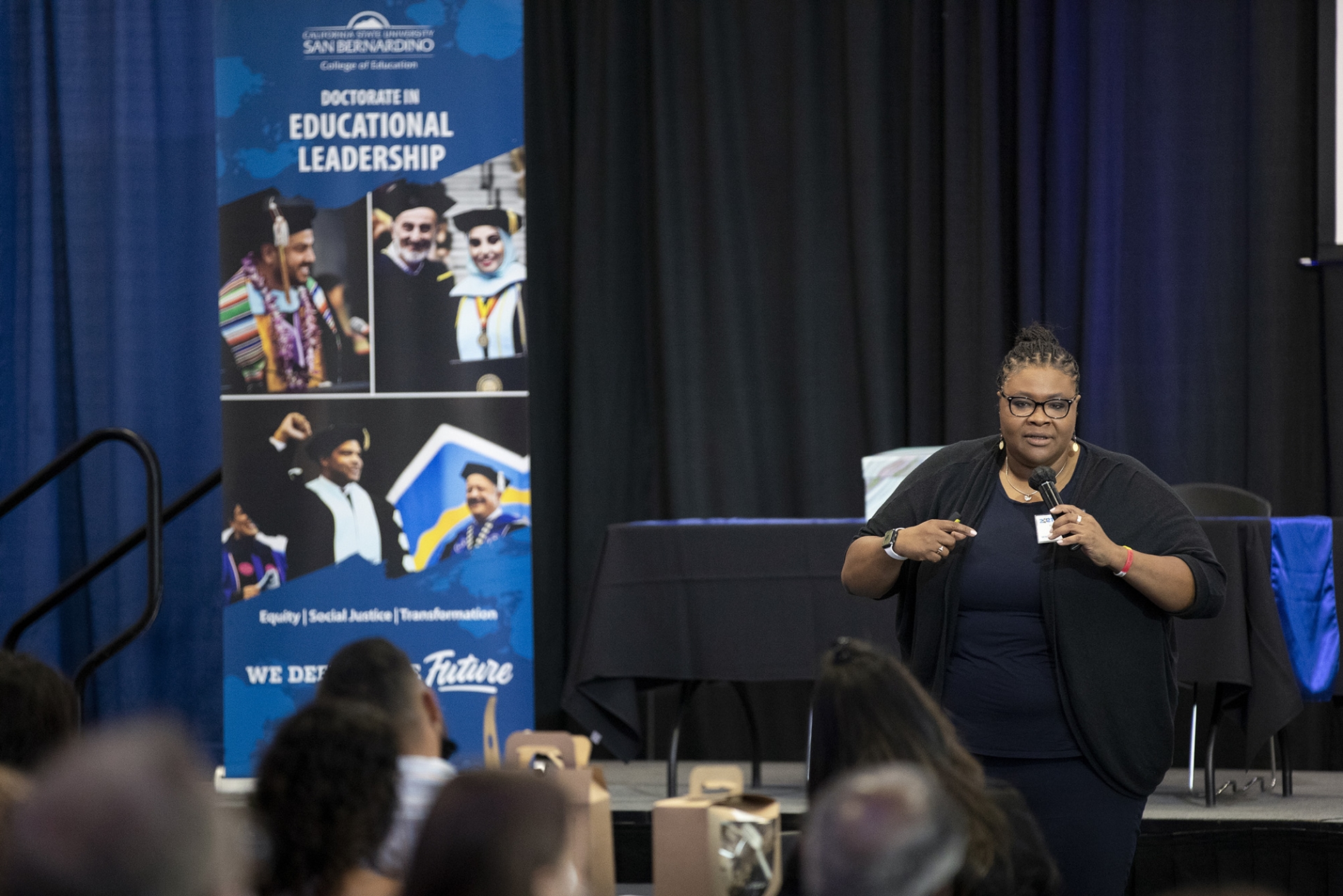Joe Gutierrez | Office of Strategic Communication | (909) 537-3007 | joeg@csusb.edu

 When Cherina Betters (’17 Ed.D.), the first chief of equity and access at San Bernardino County Superintendent of Schools, is asked, “Did you ever imagine this is the work you would be doing when you grew up?” her response is a pause and then a laugh that is filled with gratitude and warmth.
When Cherina Betters (’17 Ed.D.), the first chief of equity and access at San Bernardino County Superintendent of Schools, is asked, “Did you ever imagine this is the work you would be doing when you grew up?” her response is a pause and then a laugh that is filled with gratitude and warmth.
“No,” she says. “I never imagined this. I thought I would be an attorney or a teacher. So I knew I would pursue my education. But this?”
Another pause.
“I am surprised with me.”
As she speaks about her career path, Betters frankly admits that where she has ended up is the result of “a series of things I stumbled into.” But her thoughtful and deliberative process, which is clear she has brought to her decision making, soon comes to the forefront.
“Before I even applied to getting my doctorate, I had a series of conversations with people. About the work I was doing,” she says. “And they said to me, ‘Some of the environment you are creating, it can’t be duplicated.’”
But Betters disagreed.
“It got me thirsty,” she says. “I had to prove these people wrong.”
The work she was doing included teaching in San Jacinto Unified School District and Yucaipa-Calimesa Joint Unified School District. She calls the latter, “the house that built me” (a Miranda Lambert fan, she credits the singer with that inspirational phrase).
“I spent just about my entire adult teaching career in Yucaipa,” she says. “By the end of my time there, it broke my heart to leave.”
Betters was told, when she arrived in Yucaipa, that she was the first Black teacher to work in that school district. Her response was, “Oh, all right, cool!” She found her reception there warm and welcoming, even as she realized that she was the diversity in the room.
“It was such a flashpoint,” she recalls. “What did I get myself into? Not in a negative way; I didn’t feel demeaned.”
Instead, she thought of it as a great responsibility. By embodying the role of someone who would be viewed as breaking the color barrier, she could bring about change. But she knows that, while progress has been made since then, diversity in the Yucaipa-Calimesa School District remains a work-in-progress.
What Betters learned was the lived existence of working in a community where “the vast majority of demographics were very foreign to people who looked like me,” she says. What she gained was a knowledge of the difference between what things may seem like intellectually, and what they are like in reality.
And this is what brought her to Cal State San Bernardino’s Ed.D. in educational leadership and social justice.
She appreciated the diversity of her program cohort in terms of racial, religious and LGBTQIA+ members. “The program helped me see things,” she emphasizes. “Every inch of that degree work is poured into what I do today.”

The Ed.D. program both fully shaped her and gave her what she needed to anchor her into her groundbreaking position with San Bernardino County Schools.
Betters found that the coursework resonated with what she had come to see as her own personal pursuit: wanting people to have parity, across all dimensions of difference. Because, ultimately, the questions she found are, “How do we have these conversations in ways where we can expose things that need to be exposed? And then use them as leverage for healing throughout our area and our nation?”
The opportunity to have those necessary conversations as part of her degree work has left a deep and lasting impression on her.
She was awarded “Outstanding Doctoral Student” in her cohort. Her dissertation, with a title that also calls on a much-loved piece of music (“the Aretha Franklin version,” she clarifies), was: “Bridge Over Troubled Water: Creating an Ecology of Transformative Care for Students at Risk of Their Promise.”
In her new role as the first chief of equity and access, she represents 33 school districts and over 400,000 students. Betters notes that, as the first person in this position, she didn’t have any guiding models at hand.
The second factor, she observes, is that, “the higher you typically go in education, or in the business world, as a Black person, the fewer people you see who look like you.”
Regardless, it is clear she is focused on being the change that she wants to see. And the ultimate winner in all of this? Our children.
“I used to always think that kids were kids, no matter where you were. But I have learned that is only partially true.” Kids are shaped by the particular community, and its values, where they reside. “When communities are responsive to the evolution of what it means to be a child and the process of growing up, your outcomes are a lot better,” she concludes.
She clarifies that this is not about ranking certain communities as better or worse than the others, but rather understanding that kids’ environments provide them with different experiences. “My job is to be a thought partner, responsive to the needs of the adults, individual communities, and the students.”
Her role is, therefore, to be a bridge. This means being a constant so that whichever of the 33 school districts she is in or speaking with, they know that she is there to be the connector between their community and the ultimate goals of equity and access.
She circles back to the beginning of the conversation. “Because I never saw where I would end up has made me realize we need to see our children with a wider lens. Grow, mature, fail, get back up again: this is part of the process of childhood. We don’t know how children’s lives will go. But we need to support them throughout.”
Another pause, and then she speaks with quiet emphasis. “We need to walk along with these children. And allow them to live their fullest lives, something which is not yet known to them.”